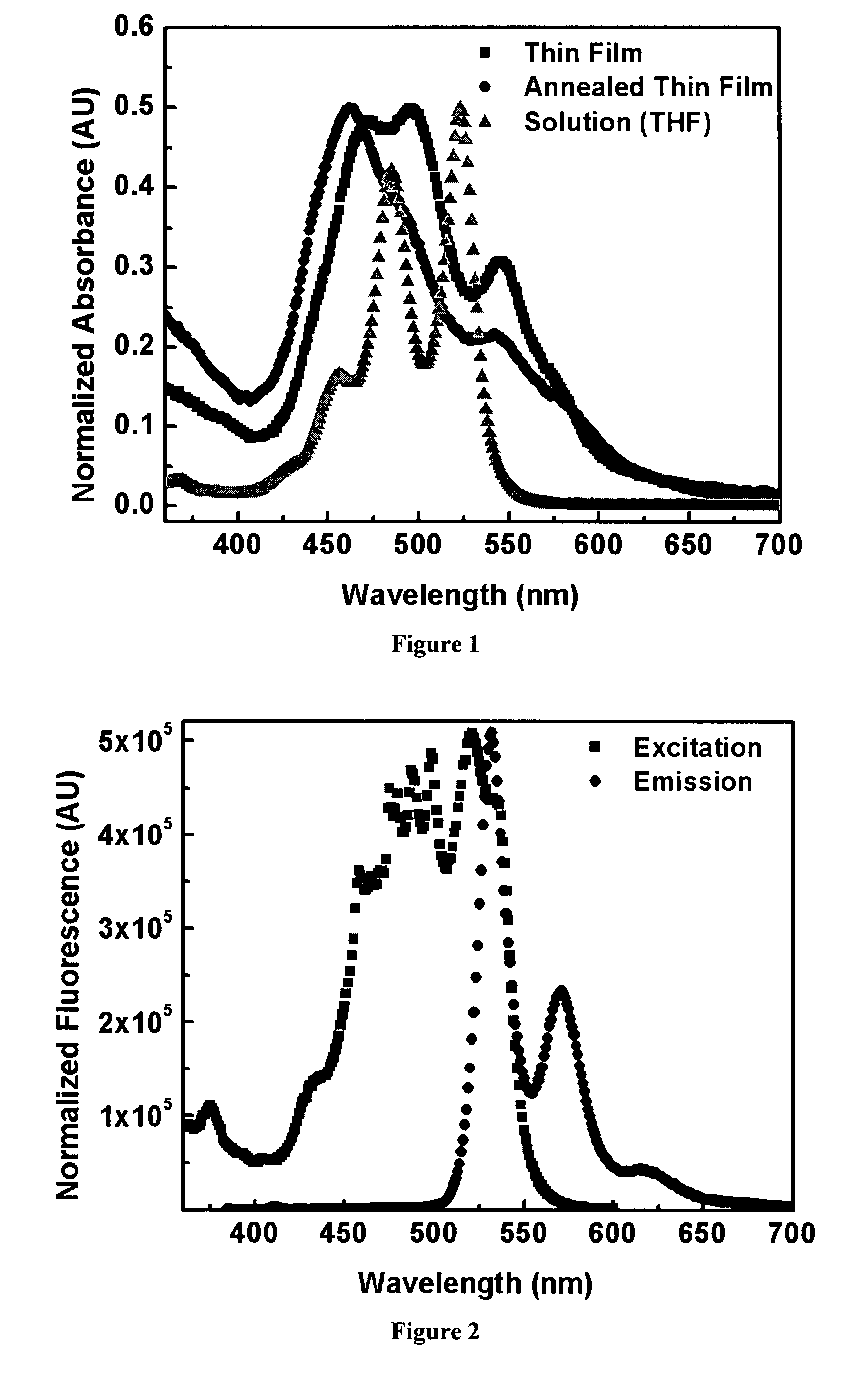Organic semiconductor materials and methods of preparing and use thereof
a technology of organic semiconductor materials and semiconductor materials, applied in the field of organic semiconductor materials, can solve the problems of limited selection of n-type organic materials, difficult and/or expensive synthesizing, limited potential manufacturing processes, etc., and achieve broad viscosity ranges and useful electrical properties.
- Summary
- Abstract
- Description
- Claims
- Application Information
AI Technical Summary
Benefits of technology
Problems solved by technology
Method used
Image
Examples
example 1
Preparation of N-(1-hexylheptyl)perylene-3,4,9,10-tetracarboxylic-3,4-anhydride-9,10-imide
[0120]Scheme 2 below illustrates an exemplary synthetic route for preparing a monomer precursor that can be used in accordance with the present teachings.
[0121]
Preparation of 1-hexylheptylamine 1
[0122]In a 250 mL round bottom flask, 5.00 g (25.5 mmol) dihexylketone, 19.7 g (255 mmol) ammonium acetate, and 1.10 g (17.8 mmol) sodium cyanoborohydride (NaBH3CN) were dissolved in 75 mL absolute MeOH and stirred at room temperature for 48 hours, until no significant amount of the starting material could be detected by NMR. The mixture was quenched by adding concentrated hydrochloric acid (HCl) dropwise (˜3 mL), then concentrated in vacuo. The resulting white solid was taken up in 500 mL water, basified to pH 10 with solid potassium hydroxide (KOH), and extracted with chloroform (CHCl3) twice (200 mL each). The CHCl3 fractions were combined and concentrated to give 4.12 g (81%) of 1-hexylheptylamine 1...
example 2
Preparation of N-(1-hexylheptyl)perylene-3,4,9,10-tetracarboxylic-3,4-anhydride-9,10-imide dimer 4
[0125]Scheme 3 below illustrates an exemplary synthetic route for the preparation of N-(1-hexylheptyl)perylene-3,4,9,10-tetracarboxylic-3,4-anhydride-9,10-imide dimer 4.
[0126]
[0127]In a 50 mL round bottom flask, N-(1-hexylheptyl)perylene-3,4,9,10-tetracarboxylic-3,4-anhydride-9,10-imide 3 (400 mg, 0.69 mmol) and 1,3-diaminopropane (23 μL, 0.27 mmol) were dissolved in imidazole (2.5 g) and stirred for 6 hours at 180° C. The reaction mixture was cooled, suspended in 5 mL of ethanol (EtOH), then treated with 40 mL of 2M HCl and stirred overnight. The black precipitate was filtered and dried at 130° C. to give N-(1-hexylheptyl)perylene-3,4,9,10-tetracarboxylic-3,4-anhydride-9,10-imide dimer 4 as a black solid (315 mg, 39%). 1H NMR (CHCl3, 500 MHz): δ 0.84 (t, 12H), 1.24 (m, 24H), 1.34 (m, 8H), 1.89 (m, 4H), 2.26 (m, 4H), 2.37 (m, 2H), 4.43 (s, 4H), 5.18 (m, 2H), 8.53-8.61 (dd, 16H); 13C NMR...
example 3
Preparation of N-(1-hexylheptyl)perylene-3,4,9,10-tetracarboxylic-3,4-anhydride-9,10-imide polymer 5
[0128]Scheme 4 below illustrates an exemplary synthetic route for the preparation of N-(1-hexylheptyl)perylene-3,4,9,10-tetracarboxylic-3,4-anhydride-9,10-imide polymer-5.
[0129]
[0130]In a 50 mL round bottom flask, N-(1-hexylheptyl)perylene-3,4,9,10-tetracarboxylic-3,4-anhydride-9,10-imide 3 (800 mg, 1.4 mmol) and polyaminoethylene (0.1 mmol) were dissolved in imidazole (3.0 g) and stirred for 3 days at 180° C. The reaction mixture was cooled, added into EtOH (20 mL), then treated with 50 mL of 2M HCl and stirred overnight. The black precipitate was filtered and dried at 130° C. to give the N-(1-hexylheptyl)perylene-3,4,9,10-tetracarboxylic-3,4-anhydride-9,10-imide polymer 5 as a brown solid (160 mg).
PUM
| Property | Measurement | Unit |
|---|---|---|
| Ri | aaaaa | aaaaa |
| solubility | aaaaa | aaaaa |
| solubility | aaaaa | aaaaa |
Abstract
Description
Claims
Application Information
 Login to View More
Login to View More - R&D
- Intellectual Property
- Life Sciences
- Materials
- Tech Scout
- Unparalleled Data Quality
- Higher Quality Content
- 60% Fewer Hallucinations
Browse by: Latest US Patents, China's latest patents, Technical Efficacy Thesaurus, Application Domain, Technology Topic, Popular Technical Reports.
© 2025 PatSnap. All rights reserved.Legal|Privacy policy|Modern Slavery Act Transparency Statement|Sitemap|About US| Contact US: help@patsnap.com



